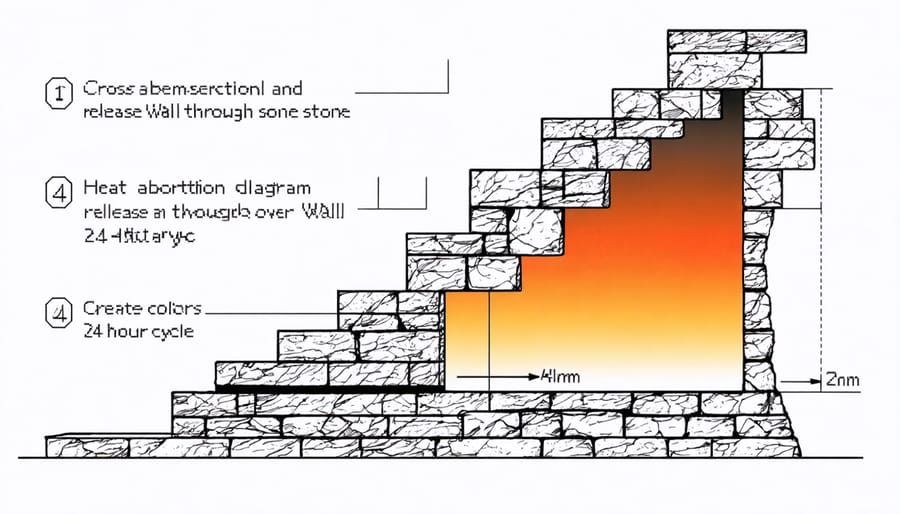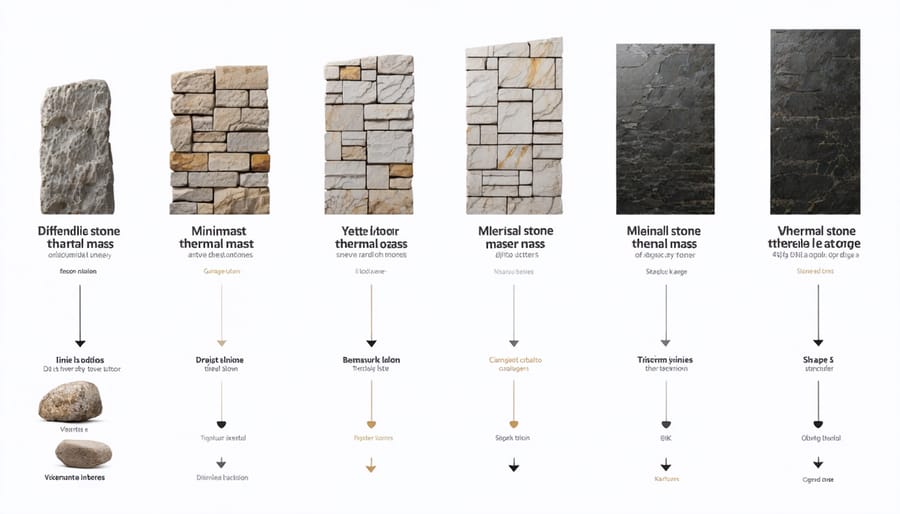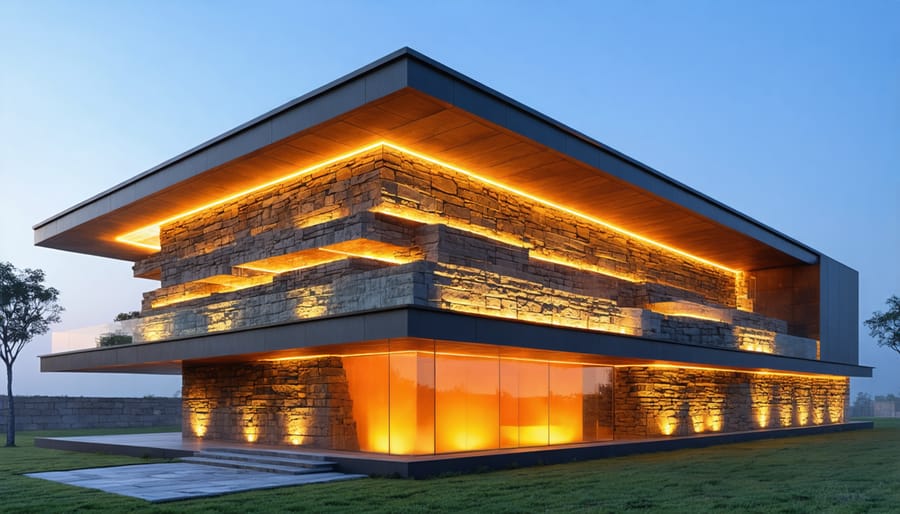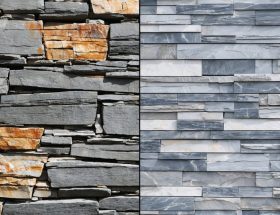In the quest for sustainable building design, thermal mass materials stand as silent powerhouses of energy efficiency. Natural stone, concrete, and water walls absorb heat during peak temperatures and release it gradually when needed, creating a natural temperature regulation system that can reduce HVAC costs by up to 30%. This ancient building principle, refined through modern engineering, transforms passive structures into dynamic energy management systems. By strategically incorporating these materials into walls, floors, and architectural features, buildings maintain comfortable temperatures with minimal energy input. The thermal storage capacity of materials like granite, limestone, and marble not only stabilizes indoor environments but also provides a sustainable solution to rising energy costs and environmental concerns. Understanding and leveraging these properties enables architects and homeowners to create spaces that work in harmony with natural temperature cycles, delivering both comfort and efficiency.
What Makes Natural Stone a Thermal Mass Champion?
Density and Heat Capacity
The ability of stone to store and release heat effectively stems from two key physical properties: its density and specific heat capacity. Most natural stones have high densities, typically ranging from 2,000 to 3,000 kg/m³, which allows them to pack more mass into a given volume. This dense structure enables stones to absorb and retain significant amounts of thermal energy.
Specific heat capacity, measured in joules per kilogram per degree Celsius (J/kg·°C), indicates how much energy a material can store for each degree of temperature change. Natural stones generally have specific heat capacities between 800 and 1,000 J/kg·°C. When combined with their high density, this results in excellent thermal mass properties.
During the day, stone materials slowly absorb heat from their surroundings, whether from direct sunlight or ambient air temperature. As temperatures drop at night, the stored heat is gradually released back into the environment. This time-delayed heat transfer process, known as thermal lag, helps regulate indoor temperatures and reduce temperature fluctuations.
The effectiveness of stone’s thermal mass properties depends on factors such as material thickness, surface area, and exposure to heat sources. Darker stones typically absorb more solar radiation, while lighter-colored stones reflect more heat.

Heat Transfer Properties
The heat transfer properties of stone make it an exceptional material for thermal mass applications. Stone conducts heat at a moderate rate, allowing it to gradually absorb thermal energy during warm periods and release it slowly when temperatures drop. This characteristic creates a natural temperature-regulating effect in buildings.
Different types of stone exhibit varying thermal conductivity rates. For example, granite typically conducts heat at 1.7-4.0 W/(m·K), while limestone ranges from 1.0-2.9 W/(m·K). This moderate conductivity ensures that heat moves through the material at an ideal pace for maintaining stable indoor temperatures.
When exposed to direct sunlight or ambient heat, stone absorbs thermal energy throughout its entire mass. As temperatures cool, this stored heat radiates back into the surrounding space at a steady rate. This process, known as thermal lag, helps minimize temperature fluctuations and reduces the need for mechanical heating and cooling systems. The dense structure of stone also prevents rapid heat loss, making it particularly effective in climates with significant daily temperature variations.

Energy Savings Through Stone’s Thermal Mass
Summer Benefits
During summer months, high thermal mass materials like natural stone prove invaluable in maintaining comfortable indoor temperatures while reducing cooling costs. As temperatures rise during the day, stone’s dense structure absorbs and stores excess heat that would otherwise warm interior spaces. This natural cooling effect is particularly noticeable in regions with significant temperature fluctuations between day and night.
The process works through a phenomenon called thermal lag, where stone’s mass delays heat transfer by several hours. As outdoor temperatures peak in the afternoon, the stone continues to maintain cooler morning temperatures inside. By evening, when outside temperatures drop, the stored heat gradually dissipates, creating a natural cooling cycle that reduces the burden on air conditioning systems.
This cooling efficiency is especially effective when combined with proper ventilation strategies. Night cooling, where cool evening air circulates through the building, helps release stored heat and prepares the stone to absorb heat again the next day. Strategic placement of stone elements, such as interior walls or flooring in areas receiving direct sunlight, maximizes this cooling potential.
Studies show buildings incorporating high thermal mass materials can reduce cooling energy consumption by 25-35% compared to conventional construction. This translates to significant cost savings while maintaining more stable and comfortable indoor temperatures throughout summer months.
Winter Advantages
During winter months, high thermal mass materials like natural stone prove invaluable for maintaining comfortable indoor temperatures while reducing heating costs. As sunlight enters through windows during the day, stone walls and floors absorb and store this solar heat energy. This stored warmth is then gradually released during colder evening hours, creating a natural heating system that helps maintain consistent indoor temperatures.
The effectiveness of stone’s thermal mass properties is particularly noticeable in rooms with direct sunlight exposure. A well-designed stone feature wall or floor can absorb enough heat during sunny winter days to reduce heating requirements by up to 25% in some cases. This passive solar heating works best when combined with proper insulation and strategic window placement.
Dark-colored stones, such as slate or granite, are especially effective at absorbing and retaining heat due to their higher heat absorption coefficients. When incorporated into south-facing walls or floors in northern hemisphere buildings, these materials maximize solar heat gain during winter months.
The delayed heat release characteristic of stone also helps prevent the sharp temperature drops that typically occur after sunset. This natural temperature regulation reduces the strain on heating systems and creates more comfortable living spaces. For optimal winter performance, stone elements should be positioned where they can receive direct sunlight while being protected by proper insulation on their exterior sides.
Best Natural Stones for Thermal Mass
Natural stone has long been valued for its exceptional thermal mass properties, with different varieties offering unique benefits for energy-efficient construction. Among the various heat-resistant stone types, several stand out for their superior thermal performance.
Granite ranks among the most effective natural stones for thermal mass, with a density of approximately 2,600-2,800 kg/m³ and excellent heat retention capabilities. Its crystalline structure allows it to absorb heat slowly during the day and release it gradually at night, making it ideal for climate control applications.
Limestone, particularly dense varieties, offers impressive thermal mass properties with a density ranging from 1,760-2,560 kg/m³. Its porous nature contributes to moderate heat absorption and release rates, providing balanced temperature regulation in both residential and commercial spaces.
Slate delivers exceptional thermal mass performance due to its dense, layered structure. With a density of about 2,700-2,800 kg/m³, slate can store significant amounts of heat energy and release it steadily over time. This makes it particularly effective in passive solar design applications.
Sandstone, while slightly less dense than granite or slate at 2,000-2,600 kg/m³, still provides substantial thermal mass benefits. Its varying composition affects its heat storage capacity, with denser varieties offering better performance for temperature regulation.
For optimal results, stone thickness plays a crucial role. Generally, a minimum thickness of 4 inches (10cm) is recommended to achieve effective thermal mass properties. The stone’s finish can also impact its performance, with darker, rougher surfaces typically absorbing more solar energy than lighter, polished ones.
When selecting natural stone for thermal mass applications, consider factors such as:
– Local climate conditions
– Building orientation
– Interior vs. exterior application
– Maintenance requirements
– Cost considerations

Strategic Placement for Maximum Benefit
Interior Applications
High thermal mass materials like natural stone are most effective when strategically placed within interior spaces. Flooring is a prime location, particularly in areas that receive direct sunlight through windows or skylights. Stone floors in sunrooms, living areas, and south-facing rooms can absorb heat during the day and release it gradually during cooler evening hours.
Kitchen countertops and islands made from dense stone materials not only provide durability but also contribute to temperature regulation. Similarly, stone feature walls in living spaces can act as passive heat sinks, especially when positioned to receive direct sunlight during winter months.
Bathrooms benefit from stone’s thermal properties, as these materials help maintain consistent temperatures and reduce moisture fluctuations. Interior stone columns or structural elements near windows can maximize solar heat gain, while stone fireplace surrounds enhance heating efficiency by storing and gradually releasing warmth from the fire.
For optimal performance, consider incorporating stone elements in rooms where temperature stability is most desired, such as bedrooms or home offices. The material thickness should typically be 4-6 inches to achieve maximum thermal mass benefits.
Exterior Applications
In exterior applications, high thermal mass materials like natural stone play a crucial role in managing outdoor temperatures and enhancing landscape design. Strategic placement of stone elements can create comfortable microclimates and reduce energy costs. Retaining walls, pathways, and patios constructed from dense stone materials absorb heat during the day and release it gradually at night, helping to moderate temperature fluctuations in outdoor spaces.
South-facing stone walls are particularly effective in cold climates, capturing and storing solar heat that can help warm adjacent areas. In hot climates, properly positioned stone structures can provide natural cooling by creating shaded areas and releasing stored coolness during peak daytime temperatures.
Water features incorporating stone elements add another dimension to thermal mass benefits. The combination of stone and water creates a cooling effect through evaporation, while the stone’s thermal properties help maintain consistent water temperatures. Popular applications include stone-lined reflecting pools, fountains, and cascading water features that enhance both the aesthetic and functional aspects of outdoor spaces.
For optimal performance, consider using darker-colored stones in cold climates to maximize heat absorption and lighter-colored stones in warm regions to reflect excess heat.
High thermal mass materials, particularly natural stone, represent a powerful tool in creating energy-efficient, comfortable, and sustainable buildings. These materials offer numerous advantages that make them invaluable in modern construction and renovation projects. By effectively storing and releasing heat, they help maintain stable indoor temperatures, reduce energy consumption, and decrease heating and cooling costs.
The benefits extend beyond mere energy efficiency. High thermal mass materials contribute to improved indoor comfort, reduced carbon footprint, and long-term cost savings. Their durability ensures these advantages persist throughout the building’s lifetime, making them a wise investment for both residential and commercial applications.
Implementation of high thermal mass materials requires careful consideration of factors such as climate, building orientation, and specific material properties. However, the rewards of proper integration are substantial. Whether incorporating stone walls in new construction or adding thermal mass elements during renovation, these materials can significantly enhance building performance.
As we face increasing environmental challenges and energy costs, the role of high thermal mass materials becomes even more critical. Their natural ability to regulate temperature aligns perfectly with sustainable building practices and modern energy efficiency goals. By choosing these materials, property owners and designers can create buildings that are not only beautiful and functional but also environmentally responsible and energy-efficient.
Consider incorporating high thermal mass materials in your next building project to experience these benefits firsthand. The initial investment will pay dividends through reduced energy costs, enhanced comfort, and increased building value for years to come.










